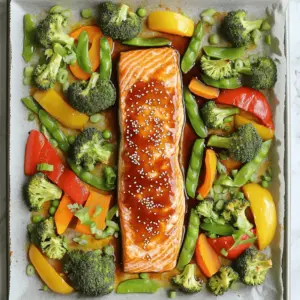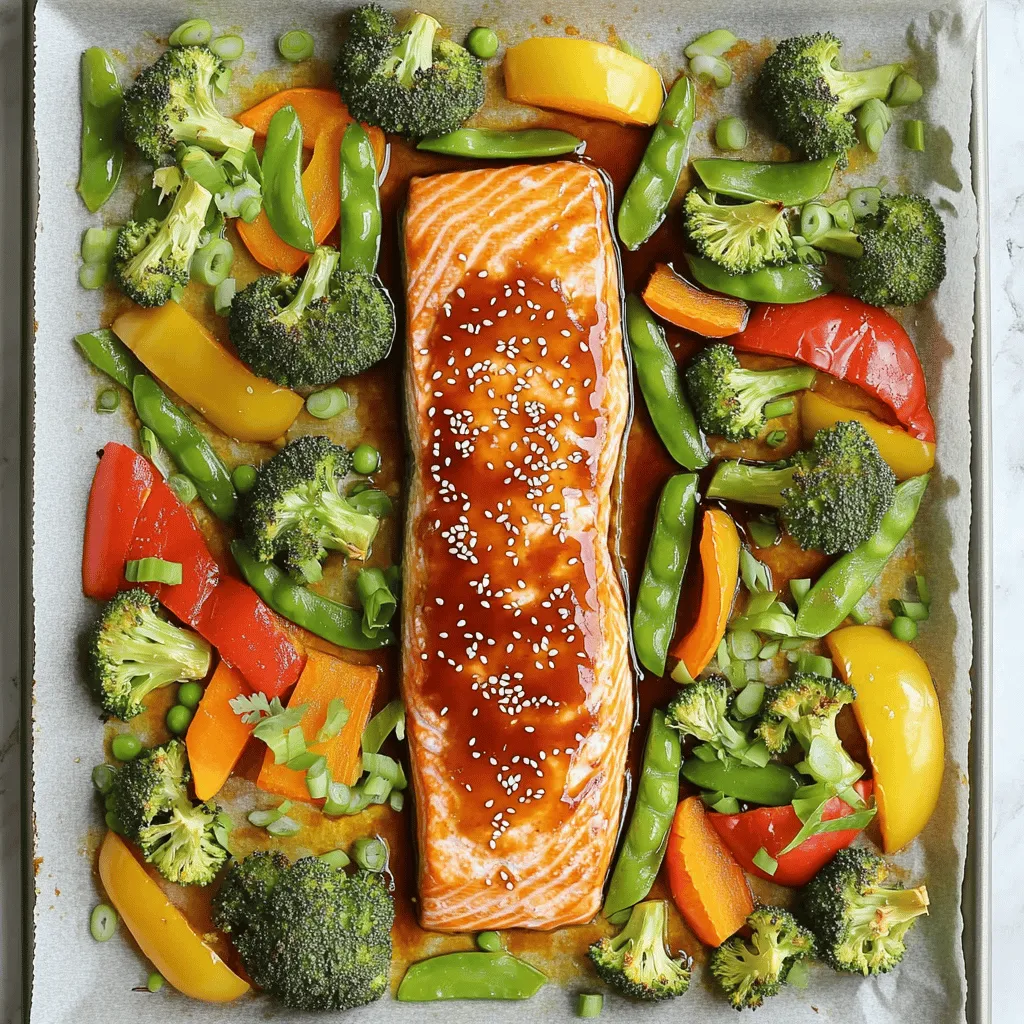Get ready to enjoy a quick and tasty meal with my Sheet-Pan Teriyaki Salmon and Veggies Delight! This dish combines fresh salmon and colorful veggies, all cooked together with a savory teriyaki glaze. It’s perfect for busy weeknights and packed with flavor. In just a few easy steps, you can whip up a delightful dinner that your whole family will love. Let’s dive into the ingredients and get started!
Ingredients
Main Ingredients
– 4 salmon fillets
– 2 cups broccoli florets
– 1 cup bell peppers (mixed colors), sliced
– 1 cup snap peas
Marinade Components
– 1/4 cup low-sodium teriyaki sauce
– 2 teaspoons grated fresh ginger
– 2 cloves garlic, minced
Seasoning and Garnish
– 2 tablespoons olive oil
– Salt and pepper to taste
– 1 tablespoon sesame seeds (for garnish)
– 2 green onions, sliced (for garnish)
When I prepare this dish, I love how simple it is. The main ingredients are fresh and colorful. Salmon is the star, with its rich flavor and healthy fats. I use four fillets, each about 6 ounces. Broccoli florets add crunch. I like to mix in bell peppers for sweetness. Snap peas offer a nice snap.
The marinade is crucial. I use low-sodium teriyaki sauce for a balanced taste. Grated fresh ginger brings warmth and zest. Minced garlic adds depth. These flavors work together beautifully to coat the salmon and veggies.
I also add olive oil to keep everything moist. A sprinkle of salt and pepper enhances the taste. Finally, I garnish with sesame seeds and green onions. They add a lovely touch and a bit of crunch. This dish is not only easy to make but also looks stunning on the table.
Step-by-Step Instructions
Preparing the Oven and Baking Sheet
First, set your oven to 400°F (200°C) to preheat. This temperature helps the salmon cook evenly. While the oven heats up, grab a large baking sheet. Line it with parchment paper. This makes cleanup easy later.
Making the Teriyaki Marinade
In a small bowl, mix 1/4 cup of low-sodium teriyaki sauce with 2 teaspoons of grated fresh ginger and 2 minced garlic cloves. Stir well until everything combines into a smooth sauce. This marinade adds a sweet and savory taste to the salmon.
Arranging Ingredients on the Sheet Pan
Next, place the four salmon fillets in the center of your baking sheet. They should have space around them. Now, add the veggies: 2 cups of broccoli florets, 1 cup of sliced bell peppers, and 1 cup of snap peas. Arrange them around the salmon.
Drizzle 2 tablespoons of olive oil over the veggies. Season with salt and pepper to taste. Toss the vegetables gently to coat them evenly with oil and seasoning. Pour the teriyaki mixture over the salmon and veggies. Make sure the salmon is well covered with the sauce.
Cooking Process
Now, it’s time to bake. Place the baking sheet in your preheated oven. Bake for 15 to 20 minutes. This time allows the salmon to cook through and the veggies to become tender but still crisp.
To check if the salmon is done, use a fork. If it flakes easily, it is ready. If not, give it a few more minutes. Once done, take it out of the oven and let it rest for a couple of minutes. Garnish with sesame seeds and sliced green onions before serving. Enjoy your meal!
Tips & Tricks
Achieving the Perfect Salmon
To cook salmon perfectly, time matters. Salmon fillets that are about one inch thick need 15-20 minutes at 400°F. If your fillets are thicker, add a few more minutes. A good rule is to check for doneness around the 15-minute mark. You want the salmon to flake easily with a fork. The center should look opaque and not translucent.
Enhancing Vegetable Texture
For crunchy vegetables, cut them into similar sizes. This helps them cook evenly. Broccoli and snap peas benefit from a quick roast. Make sure to coat them well with olive oil, salt, and pepper. Avoid overcrowding the pan; give your veggies space to breathe. This prevents them from steaming and getting soggy.
Marinating Options
For the best flavor, you should marinate the salmon for at least 15-30 minutes. This allows the teriyaki sauce to soak into the fish. If you want to switch things up, try soy sauce or a homemade ginger-soy mixture. These alternatives can add unique flavors to your dish.

Variations
Substitute Proteins
You can swap salmon for other proteins. Tilapia works well and cooks fast. Chicken is another good choice. Just cut it into even pieces for even cooking. For plant-based options, tofu is a great pick. It soaks up flavors and adds protein. Press the tofu to remove extra water. Then, cut it into cubes before marinating.
Choosing Different Vegetables
Feel free to mix up the veggies. Carrots, zucchini, or asparagus all taste great. You can use any colorful vegetable you like. Seasonal veggies add freshness. In spring, use peas and spring onions. In fall, try Brussels sprouts or butternut squash. The more variety, the better!
Preparing for Different Diets
If you’re gluten-free, choose a gluten-free teriyaki sauce. Many brands offer this option. For low-carb diets, skip the peas or bell peppers. You can add leafy greens like spinach or kale instead. They cook down nicely and add nutrients. Adjust the recipe to fit your diet needs while keeping it tasty!
Storage Info
Refrigeration Guidelines
To store leftovers, let the dish cool first. Place salmon and veggies in an airtight container. This helps keep them fresh. Use a glass or plastic container that seals tightly. Store them in the fridge for up to three days.
Reheating Methods
For reheating, use the oven or microwave. In the oven, preheat it to 350°F. Place the salmon and veggies on a baking sheet. Heat for about 10 minutes. In the microwave, use a microwave-safe dish. Cover it with a lid or wrap. Heat it in short bursts, checking often. This helps keep the salmon moist and the veggies crunchy.
Freezing Tips
Yes, you can freeze this dish! To freeze, let it cool before packing. Use a freezer-safe container or a heavy-duty bag. Label it with the date and contents. This helps you track how long it’s been frozen. It can last for about three months in the freezer.
FAQs
How long does it take to cook salmon at 400°F?
Cooking salmon at 400°F takes about 15-20 minutes. The key is checking for doneness. Salmon is ready when it flakes easily with a fork. The center should look opaque and moist. Keep an eye on it to avoid overcooking.
Can I use frozen salmon for this recipe?
Yes, you can use frozen salmon! Just remember to thaw it first. Place the salmon in the fridge overnight or use cold water for a quick thaw. Make sure it’s completely defrosted before cooking. This helps it cook evenly.
What should I serve with sheet-pan teriyaki salmon and veggies?
This dish pairs well with rice or quinoa. You can also serve it with a fresh salad. For a heartier meal, add some steamed dumplings. Feel free to get creative with sides that you enjoy!
Is this recipe healthy?
Absolutely! This recipe is packed with nutrients. Salmon provides omega-3 fatty acids, which are great for heart health. The veggies offer vitamins and fiber. Using low-sodium teriyaki sauce keeps it flavorful without too much salt. Overall, it’s a balanced meal!
This blog covered an easy and delicious sheet-pan teriyaki salmon recipe. You learned about the key ingredients and how to make a tasty marinade. I shared tips to get perfect salmon and crunchy veggies. You can also explore fun variations for different diets and preferences.
Cooking can be simple and enjoyable. I hope you try this recipe and make it your own.

